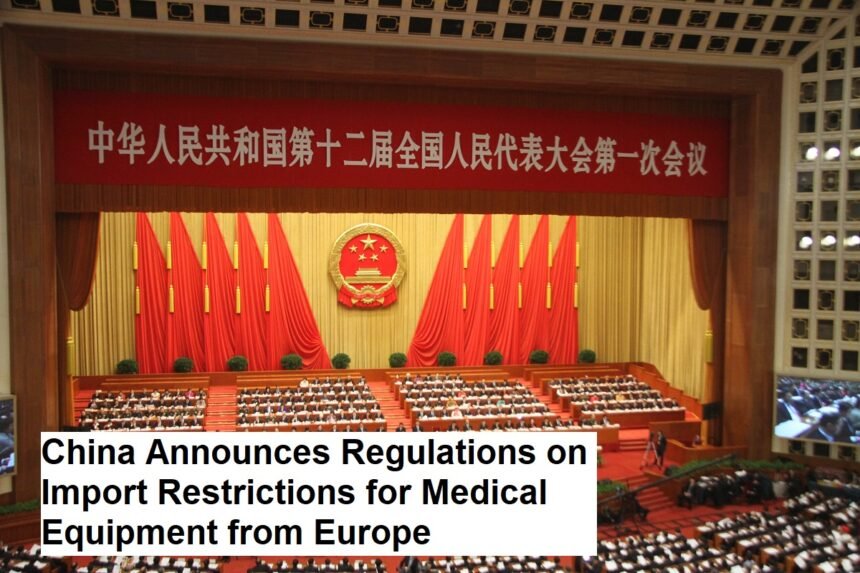Introducing
In a move that has attracted significant attention within the global healthcare and trade sectors, China recently announced new regulations that impose restrictions on the import of medical equipment from European countries. This decision has raised concerns among international manufacturers, healthcare providers, and policymakers, as it could impact the availability of vital medical supplies and influence the dynamics of international trade amidst ongoing geopolitical tensions.
Background of the New Regulations
The Chinese government, through its Ministry of Commerce and relevant regulatory bodies, announced the new import restrictions as part of broader efforts to bolster domestic manufacturing, ensure the quality and safety of imported medical devices, and safeguard national security interests. While China remains one of the world’s largest importers of medical equipment, these new rules mark a significant shift in its trade policies concerning European suppliers.
Officially, the authorities cited reasons such as concerns over the quality standards of imported devices, the need to protect local industries, and heightened scrutiny of foreign technology amid geopolitical tensions. However, industry observers believe that underlying motives may also include strategic considerations related to trade negotiations and technological independence.
Key Aspects of the Regulations
The newly introduced regulations impose strict licensing procedures and compliance requirements for companies exporting medical devices from Europe to China. Notable provisions include:
- Enhanced Certification Process: European exporters are now required to undergo rigorous certification procedures, demonstrating compliance with Chinese quality and safety standards, which are being aligned with local regulations. This process could involve additional testing, documentation, and verification steps.
- Approval Delays and Restrictions: Some categories of medical equipment may face delays in approval or outright restrictions if they fail to meet new standards or if the importing companies are not registered with Chinese authorities.
- Traceability and Data Submission: Importers must provide detailed data on product origin, manufacturing processes, and quality assurance documentation, enabling stringent traceability of all medical devices entering the country.
- Local Testing and Certification: In some cases, products will need to undergo testing within China at designated laboratories, adding further barriers and delays to the import process.
- Trade Quotas: Certain high-demand or sensitive medical devices are subject to import quotas, guiding their distribution and limiting the volume that can be imported within a specific period.
Impact on European Manufacturers and Global Supply Chains
The announcement has sent ripples through the global medical device industry. European manufacturers—known for their high-quality medical equipment—now face new hurdles in accessing one of the world’s largest markets. Companies that previously relied on direct shipments to China may need to reconsider their strategies, including establishing local partnerships or manufacturing facilities.
Healthcare providers in China could experience disruptions in the availability of imported devices, especially specialized equipment and advanced diagnostic tools. This could lead to increased demand for domestically produced alternatives, encouraging local innovation but also causing short-term shortages.
Furthermore, the regulations could disrupt global supply chains, leading to increased costs, delays, and logistical complications. Supplies such as surgical instruments, diagnostic kits, imaging devices, and ventilators might be affected, potentially impacting patient care and medical response capabilities.
Broader Political and Economic Context
This move is part of a larger trend of increased regulatory scrutiny and protective measures by China amid rising geopolitical tensions with Western nations. It parallels similar restrictions and tariffs introduced in other sectors, reflecting a strategic shift toward self-reliance and security concerns related to foreign technology.
International trade organizations and European pharmaceutical and medical device associations have expressed concerns, urging dialogue and transparency regarding these policies to prevent adverse effects on global health initiatives, especially during ongoing public health crises like the COVID-19 pandemic.
Reactions and Future Outlook
European governments and industry stakeholders have responded with caution, calling for negotiations to ensure that such restrictions do not hinder essential medical supplies or violate trade agreements. There are calls for diplomatic engagement to address mutual concerns and foster a balanced regulatory environment.
In the coming months, the impact of these regulations will become clearer as companies adjust their supply chains and explore local manufacturing options. Meanwhile, China is expected to continue emphasizing its focus on healthcare sovereignty, which could lead to further restrictions or incentives for domestic production.
Conclusion
China’s announcement of import restrictions on European medical equipment represents a significant development in global health and trade relations. While aimed at safeguarding national interests, these measures pose challenges for international manufacturers, healthcare providers, and patients worldwide. As the situation unfolds, stakeholders must navigate these regulatory changes carefully, balancing compliance, innovation, and collaboration to ensure the steady supply of vital medical devices.
Ultimately, this move underscores the evolving landscape of global healthcare trade, amid broader geopolitical shifts, emphasizing the need for resilient supply chains and international cooperation in ensuring access to high-quality medical care for all.












